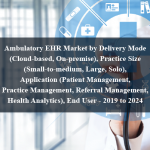OVERVIEW
Research by Global Market Studies has reported a CAGR of 7.4% for the Immunohistochemistry Market, expecting to expand to a value of USD 4.7 billion by 2028.
IHC is a widely used laboratory technique for pathology and biomedical research, detecting and localizing specific antigens in tissue sections using immunology principles. It uses specific antibodies labeled with chromogenic or fluorescent markers, allowing visualization and analysis of antigen distribution and expression levels.
IHC is crucial in cancer diagnostics, biomedical research, pharmaceutical development, neuroscience, and infectious disease diagnostics for identifying biomarkers, understanding disease processes, and assessing tissue distribution.
Table of Content
Market Dynamics
Drivers:
The increasing prevalence of chronic diseases is driving the demand for advanced diagnostic techniques like IHC, which offer valuable insights into disease diagnosis, prognosis, and treatment planning. Technological advancements have led to more sensitive antibodies, automated staining platforms, and advanced imaging systems, making IHC faster, more reliable, and easier to perform.
Personalized medicine, which tailors treatments based on an individual’s genetic and molecular characteristics, has boosted the demand for IHC to identify specific biomarkers. Biomedical research and drug development have also fueled the need for reliable and precise techniques like IHC to study disease mechanisms, identify potential drug targets, and evaluate drug candidates. Increasing healthcare expenditure, particularly in developing economies, is expected to lead to greater adoption of advanced diagnostic techniques in clinical settings.
The global aging population, associated with an increased incidence of age-related diseases, growing awareness and early detection have led to a higher demand for accurate diagnostic methods like IHC.
Opportunities:
Immunohistochemistry (IHC) offers high specificity and sensitivity in detecting target antigens, making it a reliable tool for identifying biomarkers and protein expression patterns in tissue samples. It is versatile and can be used in various fields, including cancer diagnostics, neuroscience, infectious disease research, and pharmaceutical development.
IHC aids in biomarker discovery, personalized medicine, and automation and workflow integration, streamlining laboratory workflows and reducing human errors. It also provides spatial information about protein distribution within tissues, enabling researchers to study localization and interactions of specific antigens. IHC can be combined with other molecular and histological techniques, such as in situ hybridization and fluorescence microscopy, to enhance its diagnostic and research capabilities.
Restraints:
IHC results can be subject to subjective interpretation, leading to inter-observer variability among pathologists or researchers. Standardization of protocols and training are necessary to minimize these variations. IHC requires specialized expertise and equipment, with technical challenges such as antigen retrieval, non-specific binding, and background staining impacting accuracy and reliability. It is also time-intensive, costing more than other diagnostic techniques. Limited availability of high-quality antibodies can lead to challenges in obtaining reliable results. Standardization efforts have been made, but variations in procedures, reagents, and staining platforms can impact consistency.
Regional Information:
North America: Healthcare and research are well-developed in North America. Pharmaceutical, research, and clinical diagnostics use IHC. It is used for investigating cancer biomarkers, tumor profiling, and customized treatment in the region. North American antibody, reagent, and automated staining platform producers dominate the IHC market.
Europe: Europe has strong healthcare and biomedical research.
In countries with significant oncology research centers, IHC is used for cancer diagnosis and research. European neuroscience research also relies on IHC to examine brain abnormalities and neurodegenerative diseases.
Asia-Pacific: Healthcare infrastructure and research have grown rapidly throughout Asia-Pacific. Japan, China, and South Korea use IHC for clinical diagnoses and research. IHC is used to diagnose and investigate infectious pathogens in high-burden nations.
Recent Developments:
• In February 2023, F. Hoffman-La Roche AG (Switzerland) launched IDH1 R132H (MRQ-67) Rabbit Monoclonal Antibody and the ATRX Rabbit Polyclonal Antibody for use in BenchMark series of instrument for detection of brain cancer.
• In April 2023, Danaher Corporation (US), subsidiary Leica Biosystems received FDA clearance for BOND MMR Antibody Panel, for detection of colorectal cancer.
• In January 2023, Agilent Technologies, Inc. (US) signed a partnership deal with Akoya Biosciences for developing chromogenic and immunofluorescent multiplex assays. These assays will be used for immunohistochemistry diagnostic solutions.
Key Players:
Abcam PLC, Agilent Technologies Inc, Becton, Dickinson & Company, Bio-Rad Laboratories Inc., F. Hoffman-La Roche AG, Merck KGaA, PerkinElmer Inc, and Thermofisher Scientific Inc.
Frequently Asked Questions
1) What is the projected market value of the Immunohistochemistry Market?
– The Immunohistochemistry Market is expected to reach a value of USD 4.7 billion by 2028.
2) What is the estimated CAGR of the Immunohistochemistry Market over the 2023 to 2028 forecast period?
– The Immunohistochemistry Market is expected to grow at a CAGR of approximately 7.4% from 2023 to 2028.
3) Who are the key players in the Immunohistochemistry Market?
– Abcam PLC, Agilent Technologies Inc, Becton, Dickinson & Company, Bio-Rad Laboratories Inc., F. Hoffman-La Roche AG, Merck KGaA, PerkinElmer Inc, and Thermofisher Scientific Inc.
4) What are the drivers for the Immunohistochemistry Market?
– Chronic diseases increase demand for advanced diagnostic techniques like IHC, driven by technological advancements, personalized medicine, biomedical research, and increased healthcare expenditure. The global aging population also drives the need for accurate diagnostic methods.
5) What are the restraints and challenges in the Immunohistochemistry Market?
– IHC results are subjectively interpreted, requiring standardization, specialized expertise, and equipment. Technical challenges and limited antibody availability impact accuracy.
6) What are the key applications and offerings of the Immunohistochemistry Market?
– IHC is a versatile tool for detecting target antigens, biomarkers, and protein expression patterns in tissue samples, aiding biomarker discovery, personalized medicine, and workflow integration.
7) Which region is expected to drive the market for the forecast period?
– North America has the highest value share in the global market and is expected to dominate shares in forecast period.
Why Choose Us?
Insights into Market Trends: Global Market Studies reports provide valuable insights into market trends, including market size, segmentation, growth drivers, and market dynamics. This information helps clients make strategic decisions, such as product development, market positioning, and marketing strategies.
Competitor Analysis: Our reports provide detailed information about competitors, including their market share, product offerings, pricing, and competitive strategies. This data can be used to inform competitive strategies and to identify opportunities for growth and expansion.
Industry Forecasts: Our reports provide industry forecasts, which will inform your business strategies, such as investment decisions, production planning, and workforce planning. These forecasts can help you to prepare for future trends and to take advantage of growth opportunities.
Access to Industry Experts: Our solutions include contributions from industry experts, including analysts, consultants, and subject matter experts. This access to expert insights can be valuable for you to understand the market.
Time and Cost Savings: Our team at Global Market Studies can save you time and reduce the cost of conducting market research by providing comprehensive and up-to-date information in a single report, avoiding the need for additional market research efforts.












